InterviewSolution
This section includes InterviewSolutions, each offering curated multiple-choice questions to sharpen your knowledge and support exam preparation. Choose a topic below to get started.
| 3751. |
Two points like charges Q_(A) and Q_(B) are positioned at points a and B (see figure). The electric field strength to the right of charge Q_(B) on the line that passes through the two charges varies according to a law that is represented schematically in Figure below accompaanying the problem without employing a definite scale. Assume electric field to be positive if its direct ion coincides with (the positive direction on the x-axis. THe distance between the charges is l. |
|
Answer» |
|
| 3752. |
Use (i) the Ampere's law for vecHand (ii) continuity of lines of vecB , to conclude that inside a bar magnet, (a) lines of vecHrun from the N pole to S pole, while (b) lines of vecBmust run from the S pole to N pole |
Answer» SOLUTION : We will consider here the magnetic field line of B through the bar magnet as shown above. The field line must be a closed LOOP. Let us consider it as amperian loop. Then, `int_(P)^(O) vecH .vecdl= int_(P)^(O) (vecB)/(mu_0). vecdl gt 0 ` It will be positive because the ANGLE between `vecB`and dl is less than `90^@`inside the bar magnet, so that COS `theta`is positive. So, the lines of `vecB`must run from south pole (S) to north pole (N) inside the bar magnet. According to Ampere.s law, `oint_(OPO) vecH.vecdl = 0` ` oint_(OPO) vecH.vecdl = int_(O)^(P) vecH.vecdl + int_(P)^(O) vecH.vecdl = 0 ` As ` int_(P)^(O) vecH.vecdl gt 0` ` rArr int_(O)^(P) vecH.vecdl lt= 0 ` This is because the angle between `vecH` and `vecdl`is greater than `90^(@)` . It means that the lines of H must run from north pole (N) to south pole (S) inside the bar magnet. |
|
| 3753. |
Can the potential function have an maximum or minimum in free space ? |
| Answer» Solution :No the absence of atmoshphere AROUND conductor prevents the phenomenon of electron discharge or POTENTIAL LEAKAGE. Hence the potential function does not have a maximum MINIMUM in free space . | |
| 3754. |
A boat is moving due east in a region where the earth's magnetic field is 5.0 xx 10^(-5)NA^(-1)m^(-1) due north and horizontal. The boat carries a vertical aerial 2 m long. If the speed of the boat is 1.50 m s^(-1), the magnitude of the induced emf in the wire of aerial is |
|
Answer» 0.50 mV |
|
| 3755. |
An object is projected upward with a 30^(@) launch angle and an initial speed of 60 m//s. How many second will it be in the air ? How far will it travel horizontally ? |
|
Answer» Solution :The total time the object spend in the air is equal to twice the time REQUIRED to reach the top of the trajectory (because the parabola is symmetrical ). We can FIND the time required to reach the top by setting `v_(y)` equal to 0 and then doubling that amount of time : ` v_(y) overset("set")= 0 IMPLIES v_(0_(y))+(-g) t= 0` ` t= (v_(0_(y)))/(g)=(v_(0) sin theta_(0))/(g)=((60 m//s) sin 30^(@))/(10 m//s)=3 s` Therefore, the total flight time (that is, up and down) is `T= 2t = 2xx (3s)=6s`. Now , using the first horizontal- MOTION equation, we can calculate the horizontal displacement after 6 seconds. `Delta x = v_(0_(x))T=(v_(0) cos theta) T= [(60 m//s) cos 30^(@)](6s)=310 m` By the way, the full horizontal displacement of a projectile is CALLED the projectile's range. |
|
| 3756. |
Considerthe followingsequenceof reactions. The product (B) is |
|
Answer»
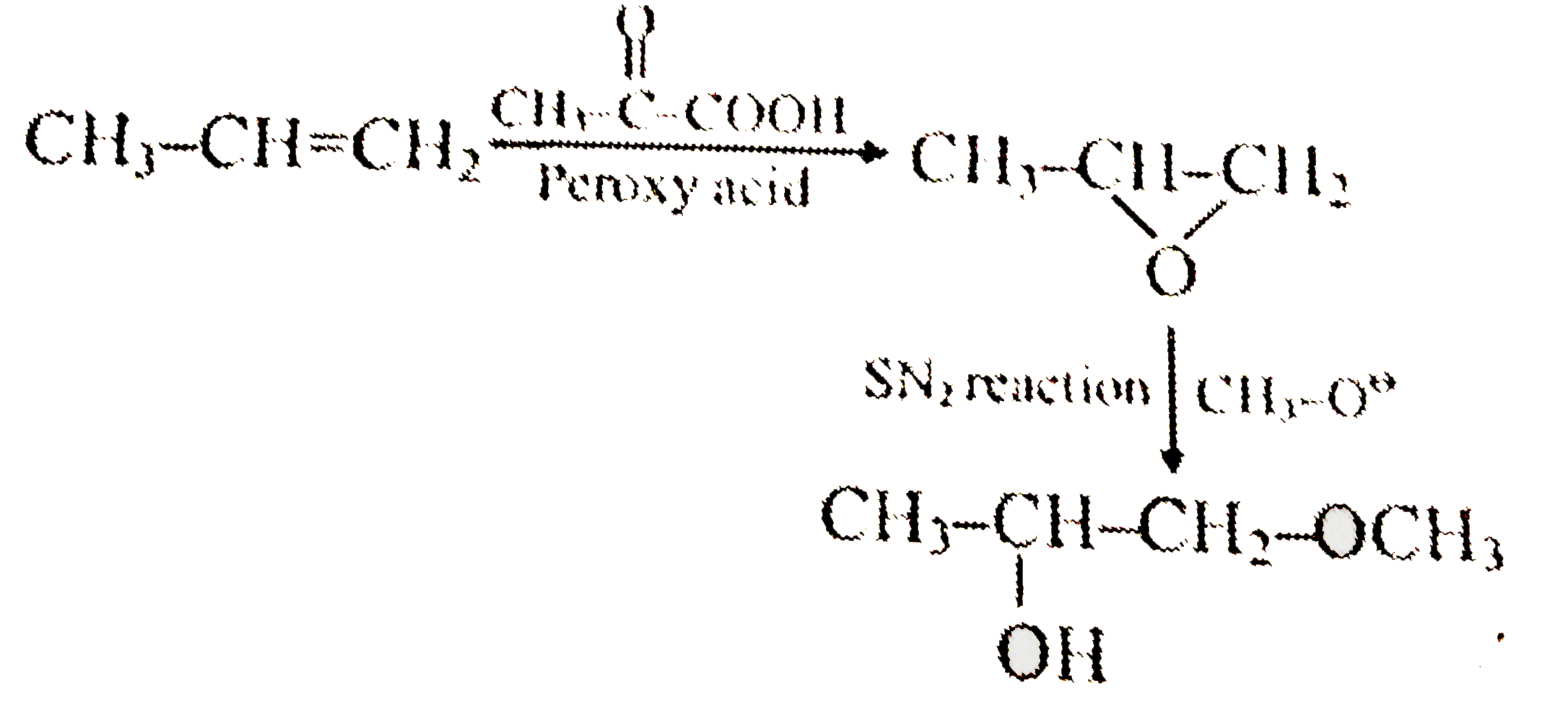
|
|
| 3757. |
The fundamental unit which is common in F.P.S and M.K.S systems is |
|
Answer» foot |
|
| 3758. |
Is the phenomenon of diffraction exhibited by all polarised, unpolarised, longitudinal or transverse waves |
|
Answer» |
|
| 3759. |
PV/3=RT, V represents volume of |
|
Answer» any AMOUNT of gas `PV=3RT` n=3 moles. |
|
| 3760. |
Energies stored in capacitor and dissipated during charging a capacitor bear a ratio |
|
Answer» `1:1` `therefore "" ("ENERGY storedin a CAPACITOR")/("Energy dissipatedduring CHARGING a capacitor") = (2)/(1)` |
|
| 3761. |
A long straight conductor kept in air carries a current of 5A. Find magnetic induction it produces at a distance of 4 cm from it. |
|
Answer» Solution :DATA: I=5A, r=4 CM=`4xx10^-2` To FIND:B `B=mu_0/(4pi)XX(2I)/r=(10^-7xx2xx5)/(4xx10^-2)=2.5xx10^-5 T` |
|
| 3762. |
A train is moving on a straight track with speed 20 ms^(-1). It is blowing its whistle at the frequency of 1000 Hz. The percentage change in the frequency heard by a person standing near the track as the train passes him is (speed of sound = 320 ms^(-1) ) close to : |
|
Answer» `12%` ` f_(2) = f [ (v)/(v + v_(s)) ]= f xx (320)/(340)` Hz 100 `xx (f_(2)/(f_(1)) - 1) = ((f_(2) - f_(1))/(f_(1))) xx 100 ` = 100` [(300)/(340) - 1 ] ` = 12 % So correct CHOICE is a. |
|
| 3763. |
Among the following four spectral regions, the photon has the highest energy in |
|
Answer» INFRARED |
|
| 3764. |
Since speed changed at a uniform rate and the average velocity is equal to the average of the Initial and final speeds. how far has the particle traveled while It was accelerating ? |
|
Answer» 51 ft v=1/2(23+58) mi/hr . V=40.5 mi/hr v=40.5 x `"5280 ft./min."/"3600 SEC./hr."` =59.41 ft/sec. X=59.4 ft./sec. x 3.5 sec X =208 ft . |
|
| 3765. |
Explain electrical energy and power. |
Answer» Solution :`rArr` Let A and B are end point of conductor.  `rArr` Let current l flow through them. Potential of A and B are V(A) and V(B) respectively. `rArr` Current flows from A to B hence V(A) `gt`V(B) and potential difference between A and B. V = V(A) - V (B) ` THEREFORE V gt 0 ` `rArr` charge `Delta Q = I Delta t `flows from A to B in `Delta t `TIME then potential energy of charge at A, `U_(1) = V(A) Delta Q and ` at ` B U_(2) = V (B) DeltaQ`. `therefore` Change in potential energy of charge , ` Delta U= U_(2) - U_(1)` ` therefore Delta U = Delta Q [ V(B) - V(A) ] ` ` = Delta Q (-V)` `= - IV Delta t lt 0 "" ` ... (1) From law of conservation of charge, `Delta K = - Delta `U `therefore Delta K = - [ - I Delta + V]` `therefore Delta K = I V Delta t gt 0 "" `... (2) `rArr` If in conductors, ELECTRO charge moves freely under effect of electric field then there will be increase in kinetic energy of electric charge. But charge moves with constant drift velocity and do not have ACCELERATED motion. `rArr` Reason behind this can be explained as follows. `rArr`During motion in conductor electron collide with ions and atoms. During this collision atoms or ions gain energy from electron. Hence, `rArr` thus, kinetic energy is converted into heat energy. |
|
| 3766. |
How many Newtons equal to one dyne |
|
Answer» `10^5` |
|
| 3767. |
(a)A beam of 450 nm light is incident on a metal having work function 2.0 eV and placed in a magnetic field B. The most energetic electron emitted perpendicular to the field are bent in circular are of radius 20 cm. Find the value of B. (b) A small plate of metal (work function =1.17 eV) is placed at a distance of 2 m from a monochromatic light source of wavelength 4.8xx10^(-7) m and power 1.0 W. The light falls normally on the plate. Find the number of photons striking the metal plate per square meter per second. If a constant uniform magnetic field of strength 10^(-4) T is applied parallel to the metal surface, find the radius of the largest circular path following by the emitted photoelectrons. |
Answer» Solution :(a) 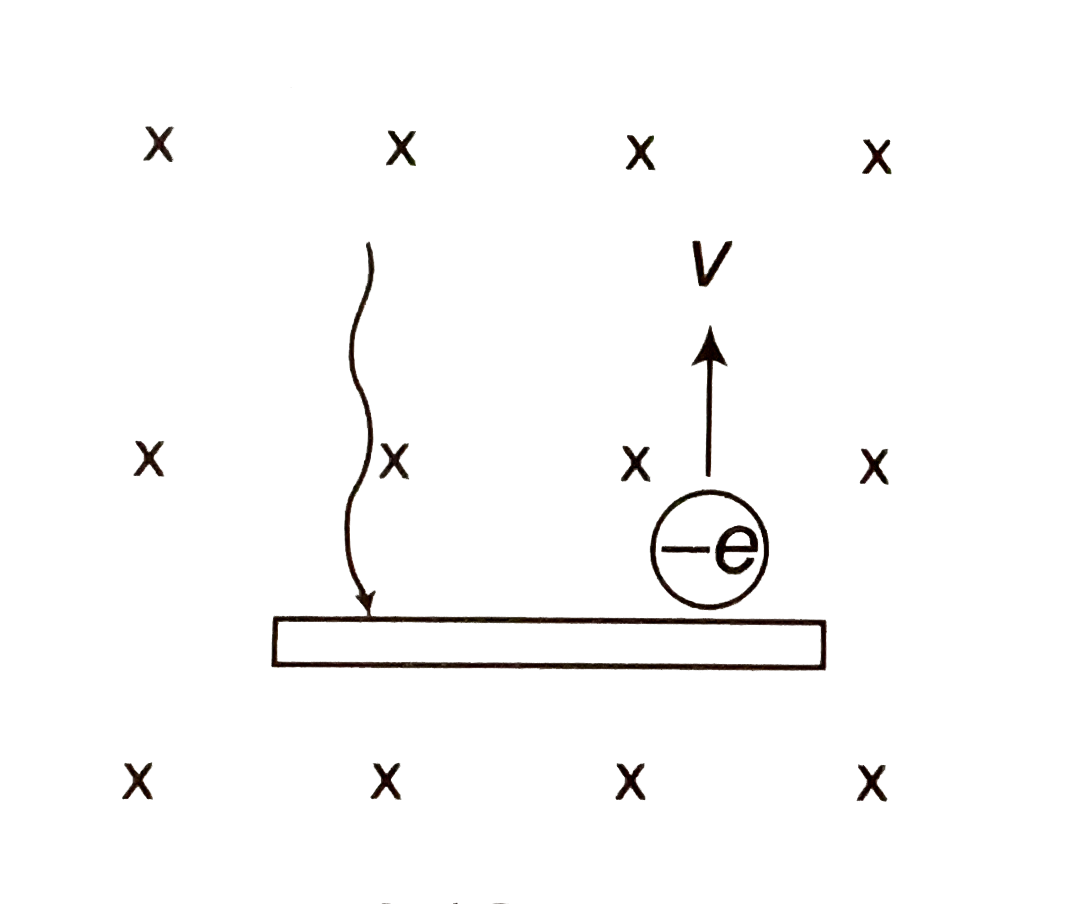 `E=(1242)/(lambda(nm))eV =(1242)/(450) =2.76 eV` `E=phi + K_(max) implies 2.76 = 2 + K_(max)` `K_(max) =0.76 eV` `R=(mv)/(Bq) =(SQRT(2mK_(max)))/(eB)` `B=(sqrt(2mK_(max)))/(eR) = (sqrt(2xx9.1xx10^(-31)xx0.76xx1.6xx10^(-19)))/(1.6xx10^(-19)xx0.2)` `=(1)/(0.2) sqrt((2xx9.1xx10^(-31)xx0.76)/(1.6xx10^(-19)))` `=(1)/(0.2)xx2.94xx10^(-6) =14.7xx10^(-6) T` (b) Intensity of light at distance r from POINT source `I=(P)/(4PI r^(2)) =n(hc)/(lambda)` `n=(I lambda)/(hc) =(P lambda)/(4 pi r^(2) hc) = (1xx4.8xx10^(-7))/(4pi(2)^(2)xx6.6xx10^(-34)xx3xx10^(8))` `=4.8xx10^(16)` `E=(1242)/(lambda(nm))eV =(1242)/(480) =2.59 eV` `E= phi + K_(max) implies 2.59=1.17+K_(max)` `K_(max) =1.42 eV` `R=sqrt(2mK_(max))/(eB) =(sqrt(2xx9.1xx10^(-31)xx1.42xx1.6xx10^(-19)))/(1.6xx10^(-19)xx10^(-4))` `=4xx10^(-2)m` |
|
| 3768. |
Zener diode is : |
|
Answer» LIGHTLY doped |
|
| 3769. |
When a spring does work on an object, we cannot find the work by simple multiplying the springforce by the object's displacement. The reason is that there is no one value for the force-it changes. However, we can split the displacement up into an infinite number of tiny parts and then approximate the force in each as being constant. Integration sums the work done in all those parts. Here we use the generic result of the integration. In Fig. 8-13, a cansiter of mass m = 0.40 kg slides across a horizontal frictionless counter with speed v = 0.50 m/s. It then runs into and compresses a spring of spring constant k = 750 N/m. When the canister is momentarily stopped by the spring, by what distance d is the spring compressed? |
|
Answer» Solution :KEYIDEA 1. The work `W_(s)` done on the canister by the SPRING force is related to the requested distance d by Eq. 8-26 `(W_(s)= -1//2 kx^(2))` , with d replacing x. 2. The work`W_(s)` is also related to the KINETIC energy of the cansiter by Eq. 8-10 `(K_(f)-K_(i)=W)`. 3. The cansiter.s Kinetic energy has an initial value of `K = 1//2 MV^(2)` and a value of zero when the canister is momentarily at rest. Calculations: Putting the first two of these ideas together, we write the work-kinetic energy theorem for the canister as `K_(f) -K_(i) = - 1/2 kd^(2)`. SUBSTITUTING according to the third key idea gives us this expression: ` 0-1/2 mv^(2) = -1/2 kd^(2)`. Simplifying, solving for d, and substituting known data then give us `d = V sqrt(m/k) = (0.50 m//s) sqrt((0.40kg)/(750 N//m))` `= 1.2xx10^(-2) m = 1.2 cm`. 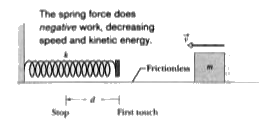 Figure 8-13 A canister moves toward a spring. |
|
| 3770. |
Assertion: Coulomb's law is valid for point charges only. Reason:The force between two large conducting spheres will be different from coulomb's formula. This happens because of electrostatic induction. |
|
Answer» Both ASSERTION and Reason are TRUE and Reason is the CORRECT explanation of Assertion |
|
| 3771. |
Which of the following is a false statement : |
|
Answer» A BODY can have zero velocity and still be accelerated |
|
| 3772. |
Equal charges q are placed at the four corners A, B, C, D of a square of length a. The magnitude of the force on the charge at B will be |
|
Answer» `(3q^2)/(4 pi epsi_0 a^2)` |
|
| 3773. |
An electromagnetic radiation has an energy 14.4eV. To which region of electromagnetic spectrum belongs to |
| Answer» Answer :A | |
| 3774. |
A doubly ionised lithium atom is H_2 -like with atomic no. 3. It is excited to produce radiations, The spectral lines observed in emission spectrum of the above excited are |
|
Answer» 4 |
|
| 3775. |
One capacitor with plate area A is being charged up. At a particular instant when charging current is I, what will be displacement current through a planar loop of area (A)/(2), imagined between the plates and parallel to them ? |
|
Answer» Solution :For a capacitor being CHARGED, conduction current density at any point inside the plate and displacement current density at any point between the plates are always same. HENCE, `(I)/(A)=(i_(d))/(((A)/(2)))` `therefore I=2i_(d)` `therefore i_(d)=(I)/(2)` |
|
| 3776. |
As the e.m. waves travell in free space |
|
Answer» ABSORPTION takes PLACE |
|
| 3777. |
In a series L-C-R circuit, resistance R = 10 Omega and the impedance Z =20 Omega. The phase = difference between the current and the voltage is ..... |
|
Answer» SOLUTION :cos `delta=R/Z` `=10/20` `=1/2` `THEREFORE delta=cos^(-1) (1/2)` `therefore delta=60^@` |
|
| 3778. |
At what value of kinetic energy is the de Broglie wavelength of an electron equal to its Compton wavelength? |
|
Answer» SOLUTION :The DE Broglie wavelength is `lambda_(DB)=((2 pi ħ)/(m_(0)V))/(sqrt(1-V^(2)//c^(2)))=(2pi ħ)/(m_(0)V)sqrt(1-V^(2)//c^(2))` and the compton wavelength is `lambda_(c )=(2piħ)/(m_(0)c)` The two are equal if `beta=sqrt(1-beta^(2))`, where `beta=(v)/(c )` or `beta=(1)/(sqrt(2))` The CORRESPONDING kinetic energy is `T=(m_(0)c^(2))/(sqrt(1-beta^(2)))-m_(0)c^(2)= (sqrt(2)-1)m_(0)c^(2)` Here `m_(0)` is the rest mass of the particle (here an electron) |
|
| 3779. |
Which one is the correct graph which gives the variation of magnetic susceptibility (x) with tempperature for adiamagneticsubstacne? |
|
Answer»
|
|
| 3780. |
What is drift velocity of free electrons ? Deduce I = n A eV_(d) where the symbols have their usual meaning. |
Answer» Solution :The average velocity with which free ELECTRONS move or drift under the infliuence of electric field. 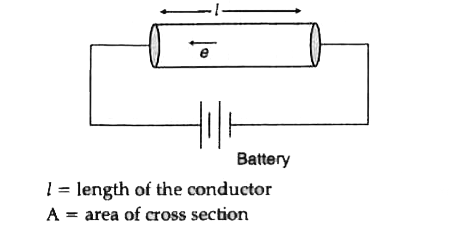 L= length of the conductor A = AREA of CROSS section n = number of free electrons/unit VOLUME e = charge of the electron Total charge `q = n A el` Drift velocity `V |_(d) =l/t or t = (l)/(V_(d))` `I = (q)/(t)` `I = ( n A el)/((l)/(V _(d))) = n A eV _(d)=l` |
|
| 3781. |
Two point charges, q_1 = 10 xx 10^(-8) C and q_2= -2 xx 10^(-8) C, are separated by a distance of 60 cm in air. Also calculate the electrostatic potential energy of the system. |
|
Answer» Solution :Here `q_1= + 10 XX 10^(-8)C and q_2 = - 2 xx 10^(-8) C` and distance between them r = 60 CM = 0.6m Electrostatic POTENTIAL energy of the system `u = (q_1q_2)/(4pi epsi_0.r) = ((10 xx 10^(-8)) xx (-2 xx 10^(-8)) xx 9 xx 10^(9))/0.6 = -3 xx 10^(-5)J` |
|
| 3782. |
An object is projected with velocity 20 ms^(-1) making an angle of 45° with horizontal. The equation for its trajectory is h = Ax - Bx^(2) where h is the height and x the horizontal distance at any instant. The ratio of constant A:B is: |
|
Answer» `1:2` `A=tantheta` and `B=g/(2U^(2)cos^(2)theta)` `A/B=(2.u^(2)cos^(2)theta.tantheta)/g=(2xx400xx1/2)/10=40/1` |
|
| 3783. |
What is depletion region in a p-n junction ? |
| Answer» Solution :A thin LAYER on both sides of the p-njunction which is devoid of free electrons and holes and contains mostly immobile ions is CALLED DEPLETION REGION. | |
| 3784. |
For the ground state, the electron in the Hatom has an angular momentum = according to the simple Bohr model. Angular momentum is a vector and hence there will be infinitely many orbits with the vector pointing in all possible directions. In actuality, this is not true, |
|
Answer» because Bohr model gives incorrect values of angular momentum. (i) Orbital motion about an axis passing through nucleus. (ii) Spinning motion about its own axis. DUE to above two types of motion, electron possesses certain definite values of angular momentum. (i.e. these values are quantized). Here if we consider spinning motion, total angular momentum values for an electron are not equal to `(nh)/(2PI)` (where n, 1, 2, 3, ..., and h = Planck.s constant). It means that these values are not according to Bohr model |
|
| 3785. |
A long solenoid has 1000 turns and its area of cross -section is 10^(-4)m^(2). If a magnetic induction of10^(-2)T is produced in it on passing a current of 1A through it , then the magnetic flux linked with it will be |
|
Answer» `10^(-1)` |
|
| 3786. |
A standing electromagnetic wave with electric component E=E_(m) cos kx. Cosomegat is sustained along the x axis in vacuum. Find the magnetic component of the wave B(x,t). Draw the approximate distribution pattern of the wave's electric and magnetic components (E and B) at the moments t=0 and t=T//4, where Tis the oscillation period. |
|
Answer» Solution :Here `oversetrarr(E) = oversetrarr(E_(m)) cos kx cos omegat` From div `oversetrarr(E) = 0` we get `E_(mx) = 0` so `oversetrarr(E_(m))` is in the `y - z` PLANE. Also `(del oversetrarr(B))/(del t) =- oversetrarr(DELTA) xx oversetrarr(E) =- Delta cos kx xx oversetrarr(E_(m)) cos omega t` `= oversetrarr(K) xx oversetrarr(E_(m)) sin kx cos omegat` so `oversetrarr(B) = (oversetrarr(k)xxoversetrarr(E_(m))/(omega)) sin kx sin omegat = oversetrarr(E_(m) sin kx sin omegat` Where `|oversetrarr(B_(m))| = (E_(m))/(C)` and`oversetrarr(B_(m)) _|_ oversetrarr(E_(m))` in the `y - z` plane. At `t = 0, oversetrarr(B) = 0, E = E_(m) cos kx` At `t = T//4 oversetrarr(E) = 0, B = B_(m) sin kx` |
|
| 3787. |
The practical unit used to measure energy in nuclear physics is |
|
Answer» ELECTRON VOLT |
|
| 3788. |
When a metallic block moves in a magnetic field induced currents are developed in the body of the block. a. What is this type of current called? b. Which law gives the direction of such currents? c. What is the strength of the induced current? |
|
Answer» Solution :a. Eddy currents b. Lenz.s law C. SINCE the metallic block has very small RESISTANCE, STRENGTH of eddy CURRENT will be very large. |
|
| 3789. |
The coefficient of self induction of a coil is: |
|
Answer» `-(E)/((DI)//DT)` |
|
| 3790. |
What are passive and active components. |
|
Answer» SOLUTION :PASSIVE COMPONENTS: Components that cannot GENERATE power in a circuit. Active components: components that can generate power in a circuit. |
|
| 3791. |
When a metallic surface is illuminated by light of frequency 8xx10^(14)Hz a photoelectron of energy 0.5eV is emitted. When the same surface is illuminated by light of frequency 12xx10^(14)Hz photoelectron of maximum energy 2 eV is emitted. The work function is : |
|
Answer» 0.5 eV `12xx10^(14)h=phi_(0)+2` Then `(12)/(8)=(phi_(0)+2)/(phi_(0)+0*5)` SOLVING `phi_(0)=2*5eV` |
|
| 3792. |
Referring to the previous illustration what will be the induced e.m.f at any instant if the loop is rotated an axis passing through the centre and parallel to the length ? |
|
Answer» Solution :The FLUX linked through the loop at any instant is `PHI` = BA COS `omega`t . `therefore` the induced e.m.f at any instant is `epsilon = (d phi )/(dt)` `RARR epsilon = -(d)/(dt)`(Blb cos `omega`t) `rArr epsilon = `+(Blb `omega"sin"omega`t) |
|
| 3793. |
If the temperature of body is increased by 100°C then the percentage decrease in it's density is [if gamma =75 ×10^-5°C^-1] |
|
Answer» 0.75 |
|
| 3794. |
Obtain an expression for magnetic energy stored in a solenoid in terms of magnetic field B, area A and length l of the solonoid. (b) How does this magnetic energy compare with the elecrostatic energy strored in a capacitor ? |
|
Answer» SOLUTION :(a) The magnetic energy is `U_(B) = (1)/(2) LI^(2)` As, `B = (mu_(0) NI)/(l)`, THEREFORE, `I = (B l)/(mu_(0) N) :. U_(B) = (1)/(2) L ((B l)/(mu_(0) N))^(2)` Using `L = (mu_(0) N^(2) A)/(l)` , we get, `U_(B) = (1)/(2) ((mu_(0) N^(2) A)/(l)) ((B l)/(mu_(0) N))^(2)` `U_(B) = (B^(2))/(2 mu_(0)) A l` (b) The volume that contains flux, `V = A xx l` `:.` Magnetic energy per unit volume, `u_(B) = (U_(B))/(V) = (B^(2))/(2 mu_(0))` It is known that electrostatic energy stored per unit volume in a parallel plate capacitor is `u_(E) = (1)/(2) in_(0) E^(2)` In both the cases. energy is DIRECTLY proportional to the square of the field strenth. Note that Eqna. (II) and (iii) have been derived for special cases -- a solenoid and a parallelplate capacitor respectively. But they are valid for any region of space in which a magnetic field `or//and` an electric field exists. |
|
| 3795. |
A wheel making 30.r.p.s. is stopped in 10s. Its angular retardation is |
|
Answer» `(2 PI rad)/s^2` |
|
| 3796. |
Name three elements required to specify the earth's magnetic field at a given place. Draw a labelled diagram to define these elements. Explain briefly how these elements are determined to find out the magnetic field at a given place on the surface of earth. |
Answer» Solution :A labelled diagram SHOWING these elements is given in FIG. 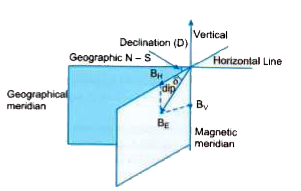 Angle of declination (D) at a place be measured by noting the DIRECTION of MAGNETIC meridian at given place by using a freely suspended magnetic needle. Then the angle subtended by magnetic meridian from geographic meridian can be determined. To determine angle of dip we TAKE a dip needle which can freely rotate in a vertical plane about a horizontal axis. The dip needle is set along the megnetic meridian . In this state angle subtended by the dip needle from horizontal direction is equal to the angle of dip. To measure value of horizontal component of earth.s megnetic field we take a small size magnetic needle of known magnetic moment m and moment of inertia I. It is freely suspended in earth.s field . Slightly rotate the needle from its equilibrium position and note its oscillation period T, which is given by `T = 2pi sqrt((I)/(mB_H)) implies B_H =(4pi^2 I)/(m.T^2)` |
|
| 3797. |
A 100 pF capacitor is connected to a 230 V, 50 Hz a.c. source, the r.m.s. value of the conduction current is |
|
Answer» 1.90 A |
|
| 3798. |
Which of the following in notcorrectly matched ? |
|
Answer»

|
|
| 3799. |
SONARis mostly used by |
|
Answer» DOCTORS |
|
| 3800. |
Which one of the following do not represent travelling Harmonic wave: |
|
Answer» A(ax-bt) |
|